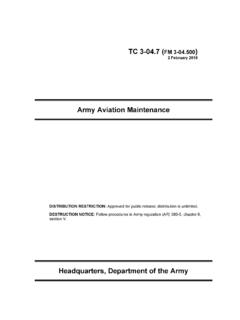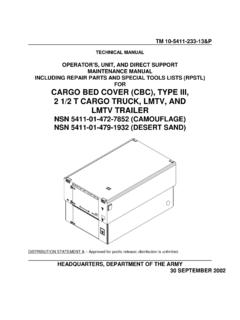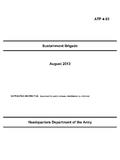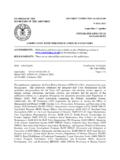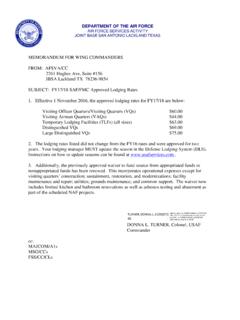Transcription of ERDC/CERL TR-11-38, Integration of Sustainment …
1 ERDC/CERL TR-11-38 Installation Technology Transfer Program Integration of Sustainment Management Systems (SMS) with the Army Installation Status Report for Infrastructure (ISR-I) Construction Engineering Research Laboratory Michael N. Grussing, Kelly M. Dilks, and Matthew C. Walters September 2011 Approved for public release; distribution is unlimited. Installation Technology Transfer Program ERDC/CERL TR-11-38 September 2011 Integration of Sustainment Management Systems (SMS) with the Army Installation Status Report for Infrastructure (ISR-I) Michael N.
2 Grussing, Kelly M. Dilks, and Matthew C. Walters Construction Engineering Research Laboratory Army Engineer Research and Development Center 2902 Newmark Drive Champaign, IL 61822 Final report Approved for public release; distribution is unlimited. Prepared for Office of the Assistant Chief of Staff for Installation Management (ACSIM) Arlington, VA 22202 Under Project FY10-12E, SMS-ISR Integration ERDC/CERL TR-11-38 ii Abstract: This report describes the process for integrating the BUILDER Sustainment Management System (SMS) with the US Army Installation Status Report for Infrastructure (ISR-I).
3 A common building component and assessment data framework between SMS and ISR-I was developed to link local facility condition and functional requirements managed through the BUILDER Sustainment Management System (SMS) to enterprise-level quality and mission metrics reported in the ISR-I. To accomplish this, the applicable facility components for all 63 ISR-I rating standards booklets were mapped to the corresponding BUILDER inventory items based on the UniFormat II classification system (ASTM E 1557-02). This data framework enables BUILDER to extract condition and functionality data from the ISR-I for certain building systems and components.
4 It also estab-lishes a foundation for uploading quality and mission capability ratings to the ISR-I for facilities that have been assessed using BUILDER. The out-come is a higher level of interoperability between the BUILDER SMS and ISR-I systems. BUILDER can use ISR-I condition data to drive the devel-opment of local installation annual work plans, and BUILDER-generated condition indices can feed ISR-I reporting requirements. DISCLAIMER: The contents of this report are not to be used for advertising, publication, or promotional purposes.
5 Citation of trade names does not constitute an official endorsement or approval of the use of such commercial products. All product names and trademarks cited are the property of their respective owners. The findings of this report are not to be construed as an official Department of the Army position unless so designated by other authorized documents. DESTROY THIS REPORT WHEN NO LONGER NEEDED. DO NOT RETURN IT TO THE ORIGINATOR. ERDC/CERL TR-11-38 iii Executive Summary The Installation Status Report for Infrastructure (ISR-I) is the US Army s strategic-level process for assessing the condition, performance, and rea-diness of facilities.
6 ISR-I facility-related mission and quality criteria are compiled and organized by component type, and published as a series of 63 rating standards booklets. Each booklet represents a major, mission-based Army facility group that encompasses one or more Facility Category Groups (FCGs). Each criterion is associated with a qualitative color scale (Red, Amber, Green) that includes narrative descriptors. These ratings are combined to determine the general status of a facility or group of facilities at an installation. The BUILDER Sustainment Management System (SMS) supports effective and efficient management of building component inventory information; condition and readiness reporting; and Sustainment , Restoration, and Modernization (SRM) facility investments.
7 BUILDER functions as a web-accessible enterprise system that provides asset recordkeeping, condition-analysis capabilities, and decision-support information to Department of Public Works personnel responsible for a large building portfolio. Imple-mentation of BUILDER allows facility managers to see critical building condition information aggregated in one location, accessible through a us-er-friendly computer interface. BUILDER has life-cycle analysis capabili-ties to perform work identification at the local installation level, but also can feed information to the ISR-I in support of higher-level reporting.
8 The objective of this project was to integrate BUILDER with the ISR-I by creating a data structure that both can use to exchange information and extend the benefits of each other. This data structure links local, tactical-level facility condition and functional requirements identified and ma-naged through BUILDER to the strategic-level quality and mission metrics reported in the ISR-I for use by headquarters elements. Individual ISR-I facility elements were linked to the corresponding BUILDER inventory items using the UniFormat II building element classification standard (ASTM E 1557-02).
9 In addition, the ISR-I color ratings were mapped as applicable to SMS Condition Index (CI) scales related to facility quality or the Functionality Index (FI) related to facility capability. This linkage pro-vides a way for BUILDER to extract ISR-I condition and functionality data ERDC/CERL TR-11-38 iv for certain building systems where applicable. It also provides a founda-tion for providing quality and mission capability ratings to populate ISR-I when a BUILDER-based assessment has been performed. Benefits By linking the two systems, BUILDER improves the utility of the ISR-I for decision support to local installation facility managers.
10 ISR-I information can populate BUILDER facility data, thus lowering SMS implementation costs. The benefit of this approach is the minimizing of time required to initially populate the BUILDER database with inventory information that interfaces readily with ISR-I quality criteria. In addition, ISR-I facility rat-ing information is collected electronically to feed BUILDER component condition ratings while simultaneously accomplishing basic ISR-I inspec-tion requirements. The outcome is a higher level of interoperability be-tween the BUILDER SMS and the ISR-I.










